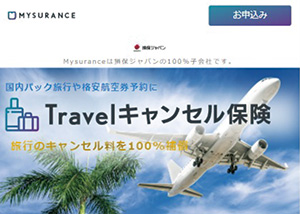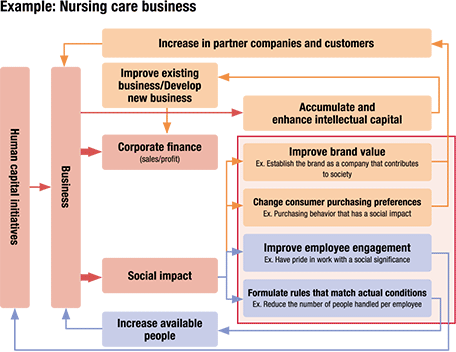
SOMPO’s Purpose Management
Improving Unrealized Financial Value
Evidence for Emerged Changes and Outcomes
Initiatives to advance emerged changes and to estimate medium- and longterm outcomes
We believe that human capital improvement initiatives originating from My Purpose will increase engagement and create Unrealized Financial Value through an increase in emerged changes, such as taking on challenges. This fiscal year, we have been working to visualize this mechanism, accumulate and analyze evidence (case studies and data) that shows that engagement contributes to improved outcomes, and visualize medium- to long-term outcomes (such as trial calculations of social impact). This part introduces some of our initiatives.
Verification of the mechanism of emerged changes
Individuals and organizations that have increased their engagement will take specific actions, represented by “taking on challenges” and “communication,” toward realizing their Purpose. Then, while involving both internal and external stakeholders, to create outcomes they will evolve and accumulate knowledge through collaboration, and increase the scale-up and sophistication of organization and business challenges. Our company refers to this series of processes as “emerged changes,” and is working to visualize them and verify them through data and case studies. However, the mechanism of changes from emerged changes to outcomes differs from company to company and department to department, and we have not yet been able to fully clarify it. We will continue to make progress in these initiatives while linking them to the strategies and measures of various areas and businesses.
1 Organizations with high engagement spend around 30% more time on tasks that create high added value
We confirmed that the top 25% of organizations with the highest engagement scores spend about 30% more time on tasks that create high added value, such as new sales, compared to organizations with average scores and below.
* For this verification, tasks that create high added value were defined as the percentage of time spent on tasks that provide value-added products and services to customers to time spent on one’s own tasks.
Increased engagement and taking on challenges impact improved performance and quality
(Example: The regression coefficient is 6.36 points for engagement score and the customer satisfaction index for auto insurance claims payments)
23 Case studies of changes that have occurred in the field
With a strong desire to contribute to the rapid rebuilding of the lives of our customers in disaster-affected areas, we developed and introduced an unprecedented system for payment of insurance claims in the event of a disaster, utilizing the “Foundry” data platform provided by Palantir. We actually used that system for payment of insurance claims for the disaster of the earthquake off the coast of Fukushima Prefecture in 2022. We were able to promptly deliver insurance claims payments to customers by significantly improving our business operations.

Based on the My Purpose to “Think about what we can do and take action so that everyone we interact with can feel as healthy and happy as possible throughout their lives,” we proposed that our city promote health and prevent serious illnesses by using our health care service “LinkCross Blood Glucose Coaching.” As a result, a consortium led by the city was formed, and the healthy and happy community development using ICT (Diabetes Prevention) project (only in Japan) using LinkCross Blood Glucose Coaching was launched and adopted as a smart city model project by the prefecture.

We developed and provide travel cancel insurance to encourage travel reservations with the strong desire to create new experiences and value with insurance by changing the “impossible” of conventional insurance to “possible.” This product has helped to realize the three-way satisfaction between users, travel agencies, and accommodations/transportation, and has contributed to the recovery of demand for domestic travel.
4 Social impacts generated by SOMPO
By organizing the impact paths and converting them into monetary values, we will clarify the social impacts we produce that go beyond the scale of our operations.
The following four paths show how social impact can lead to future financial value. We believe that these paths will lead to improvement in human capital and an increase in the number of partner companies and customers, which in turn will lead to an increase in financial value.
- (1) Improve brand value
- (2) Change consumer purchasing preferences
- (3) Improve employee engagement
- (4) Formulate rules that match actual conditions

“egaku” consists of three services: digitization support service, data utilization service, and professional service. Through the development of these services, we aim to improve the productivity of nursing care businesses, increase staff engagement, and enhance the job attraction of nursing care work. We aim to close the gap between supply and demand for caregivers by 220,000*1 and to support up to 880,000*2 seniors in 2040. We estimate that this will prevent people from quitting or restricting work for nursing care and create a social impact of up to 3.7 trillion yen in terms of GDP equivalent.

*1 Assuming deployment of “egaku” to 30% of home care providers and 10% of at-home care providers who all successfully reduce the No. of caregivers needed and increase the No. of caregivers, just like at Sompo Care.
*2 Assuming that deregulation allows 1 caregivers to support about 4 seniors.















